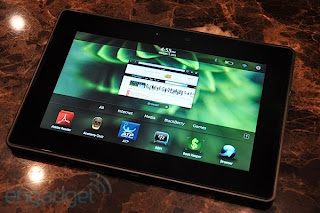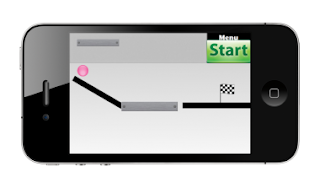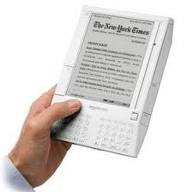According to the leak, the next iteration of Samsung Galaxy S will have the following specs. The screensize of the phone will either be 4.3-inch or 4.5-inch, but it will definitely be sporting a Super AMOLED Plus display. The phone will come with an 8-megapixel rear camera with LED flash, while the front camera will come with a 1.3-megapixel sensor.
The big surprise will be in the new Orion dual-core processor that the Galaxy S 2 will use. It’s unclear whether it will run at 1 or 1.2GHz processor though. One more thing, the S 2 may come with NFC chip inside, such that allows the phone to be used as a mobile payment device. As for the OS, expect it to ship with Android 2.3 Gingerbread.
courtesy of Techdin

We're sure RIM would still prefer that you own both a BlackBerry smartphone and a PlayBook, but it looks like it's now going some way to address the potential misconception that you actually need a BlackBerry for the tablet to be of any use. Speaking with Forbes, RIM senior product manager Ryan Bidan insisted that "on its own, this is a great standalone tablet," and that "this is not a device that is reliant on a BlackBerry." As Forbes notes, however, it is true that the PlayBook needs to be tied to a BlackBerry for most PIM functions like contacts and calendar management, but Bidan says those features will come to the PlayBook separately "as the platform evolves" -- he didn't get much more specific than that, unfortunately.
 Forbes / ENDGADGET Forbes / ENDGADGET |
GAME WRITTEN BY 14 YEAR OLD THAT PASSES ANGRY BIRDS APP

While Angry Birds is still the top paid iPhone game, a game written by an eighth-grader has spent the last few days atop Apple’s free charts.
Bubble Ball, a physics simulator, was coded by Robert Nay, a 14-year-old from Spanish Fork, Utah. The game challenges players to use objects and gravity to guide a ball to its destination.
Nay spent the better part of a couple of months writing the game, which debuted in the App Store late last year and is also available for Android devices. In recent days, though, it has been rivaling Angry Birds Lite atop the list of most downloaded free games.
“I was pretty surprised by how well it was doing,” Nay told Mobilized. Nay said he plans to add more levels to the free game and then eventually add still more games as an in-app purchase. He also has some other ideas for games he’d like to write down the road.
Although it’s his first game, Nay has been into computers for some time, including Web programming and helping others with their computers. When he’s not at the computer (or school) he also likes reading, especially science fiction, and playing the piano and trumpet.
Some months back, a friend suggested that if Nay liked his iPod touch so much, perhaps he should try his hand at programming for it. At first he tried the standard Objective-C programming tools, but found the learning curve a little steep. He tried another tool called GameSalad, but didn’t like the results. In the end, he settled on the Corona tools from Ansca Mobile. Corona was easy to use, he said, and also let him write once and publish for both Apple and Android devices.
Bubble Ball showed up in the app store on Dec. 29 and had a million downloads in the first two weeks. Last Thursday, it topped the App Store free chart and had more than 400,000 downloads on that day alone.
Robert’s mom, Kari Nay, drew some of the levels of the game, though Robert did all the coding. Kari Nay also handles the business tasks, such as submitting the apps to the App Store and Android marketplaces.
“I do the grown-up stuff for him,” she said.
APPLE SHARES GO DOWN BY 8% WHEN NEWS OF JOBS LEAVE

The knee-jerk reaction to news of Steve Jobs’s medical leave of absence from Apple was as expected, though somewhat muted by the Martin Luther King Jr. holiday in the States. U.S. markets are closed today, so Apple’s share price here remains at $348.48, its Friday close. But it’s already taking a beating abroad. As I write this, Apple’s stock is down nearly 8 percent in Frankfurt trading.
We’ll likely see a similar drop when it begins trading on the Nasdaq again tomorrow, though the company is expected to post another quarterly blowout when it reports earnings after market close. Atlantic Equities analyst James Cordwell suggests investors prepare themselves for a drop similar to the one Apple shares suffered after the announcement of Jobs’s first medical leave. “We’ve been here before at the start of 2009, so it’s probably going to be similar to that,” he told Reuters. “Operationally the company coped very well last time, but there’s a certain Jobs premium in the stock, and that will be the concern.”
And while that’s understandable, that concern is overblown. As I wrote back in January 2009, for investors to sell on news like this is just silly:
“Because if Jobs were to leave Apple–willingly or otherwise–people won’t suddenly stop buying Macs. The iPod won’t suddenly go the way of the Walkman and early adopters won’t suddenly lose interest in the next-gen iPhone. Nor will the Houdini-meets-Edison magic that Jobs has brought to Apple suddenly dissipate.
“Yes, Jobs’s sensibility pervades Apple’s culture and its products, but that culture and those products are not tethered to his health or day-to-day presence at the company. And Apple’s deep executive bench is more than capable of running it–and running it well–in his absence.
“iPhones worldwide will not stop working if something should happen to Steve–although apparently there are quite a few investors who believe this is indeed the case.
“Apple will endure–with or without Steve Jobs. There will be a post-Jobs era, and whether it begins this year or 20 years from now is of little consequence.”
HOW TO PUBLISH YOUR BOOK ON AMAZON KINDLE

If you're looking for a way to self-publish your own book on the Kindle, it's surprisingly simple. Here's the step-by-step method of making your writing available to the Kindle masses.
The only reason "A Confederacy of Dunces" was ever published is because author John Kennedy Toole's mother pulled the manuscript out of the garbage after his death.
Your book shouldn't have to travel that rocky of a road on its way to publication.
Amazon makes it a piece of cake for you to set a book loose on the Kindle e-reader platform.
Building the book:
- Write your book in Microsoft Word and save it as a .doc file. Skip the .rtf and .docx formats. They don't play nicely with the Kindle.
- Pay attention to how you format your text. Bolding, italicizing, and indenting are no problem, but steer clear of bullets, headers, footers, and fancy fonts.
- Any images you use need to be in .jpeg format with center alignment. Remember that the Kindle can only show images in grayscale.
- Mind your grammar and spelling. When you get them wrong, it,s embarrosing.
Saving in Filtered HTML format:
Once everything looks good, select File, Save as, Web Page, Filtered (*HTM &*HTML). Easy enough.
Using Mobipocket Creator
Mobipocket Creator is a piece of software that will turn your Filtered HTML document into an eBook to sell through Amazon. It's only compatible with PCs running Windows 2000/XP or greater. There aren't any solutions given on Amazon's official site for those running OSX, so find a friend running the right operating system and download the software here.
- Start it up.
- Select "HTML Document" from the section "Import from an Existing File."
- Browse to the HTML file and press "Import."
- This will open the book editing function. Click on "Cover Image."
- Click "Add a Cover Image" and browse your files to locate the book cover.
- Select your book cover and click "Update" to save your cover.
- Select "Build" from the Menu.
- On the Build page, click "Build."
- Once complete, the message "Build Finished" will appear.
- Click the circle next to "Open folder containing eBook" and select "OK."
- The file has been saved in .prc format in your My Documents/My Publications folder.
Cover your book and use Kindle Previewer
Kindle Previewer will show you exactly what the reader will see when he reads your book. Download it here and use it to open your .prc file. Did you catch a mistake? Change it in your original Microsoft Word document and go through the same process described above to output a new .prc file.
Get published
Once you're happy with your finished product, upload your .prc file here. After entering in your pricing and royalty information, click "Save and publish." Your book will appear for sale in the Amazon eBook store within 24-48 hours. Amazon gives you 70 percent of all sales. Tell your friends to buy it and tell John Grisham to eat his heart out.
Once you're happy with your finished product, upload your .prc file here. After entering in your pricing and royalty information, click "Save and publish." Your book will appear for sale in the Amazon eBook store within 24-48 hours. Amazon gives you 70 percent of all sales. Tell your friends to buy it and tell John Grisham to eat his heart out.
Alternatives
Apple is the other big player making a foray into helping authors self-publish their books. Their iBooks platform makes it a snap to buy books to read on your iPhone, iPod Touch, or iPad, but getting your book into their marketplace is considerably trickier.
Apple is the other big player making a foray into helping authors self-publish their books. Their iBooks platform makes it a snap to buy books to read on your iPhone, iPod Touch, or iPad, but getting your book into their marketplace is considerably trickier.
Before even submitting your book for their consideration, you need a manuscript in ePub format, a 13-digit ISBN, validation against ePubCheck 1.0.5, a US Tax ID, a valid iTunes Store account, and an Intel-based Mac running Leopard or higher.
None of these things are impossible, but we're much more impressed with how straightforward and accessible the same process is through Amazon.
If you want to give iBooks a try, the process starts here.
If you want to give iBooks a try, the process starts here.


